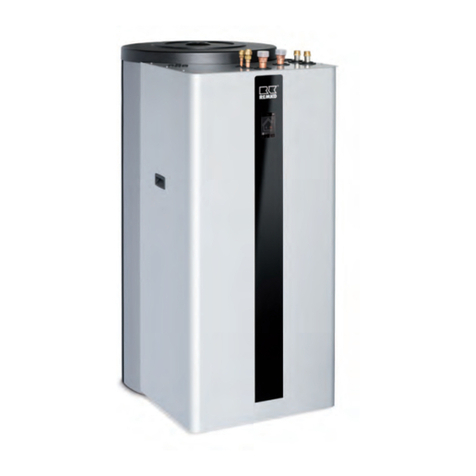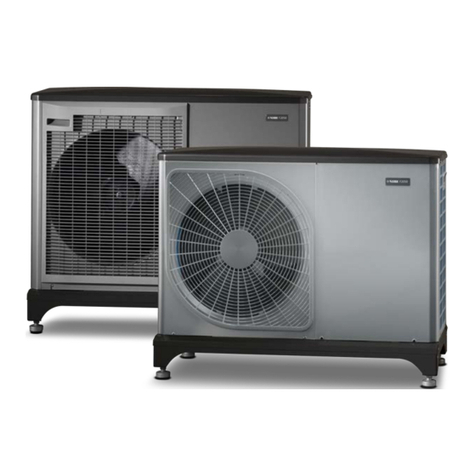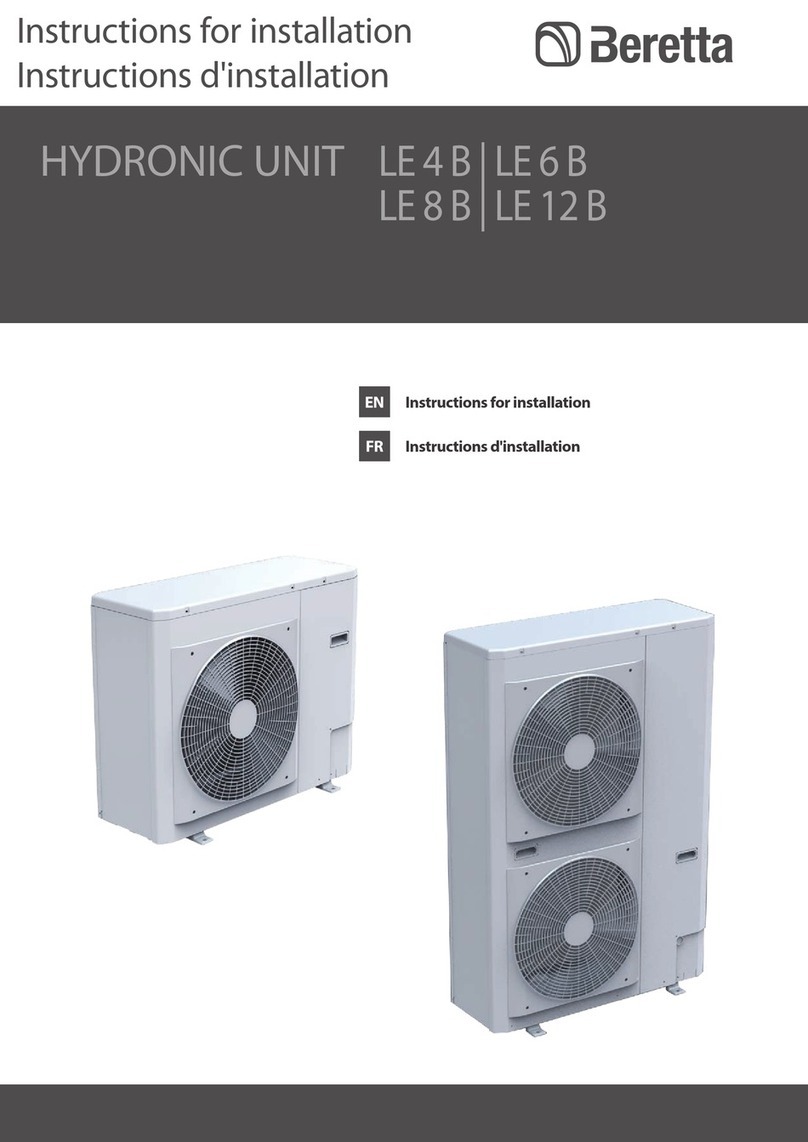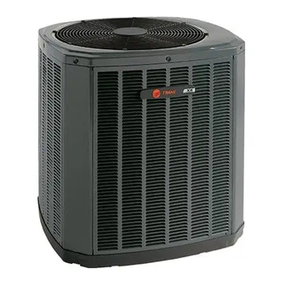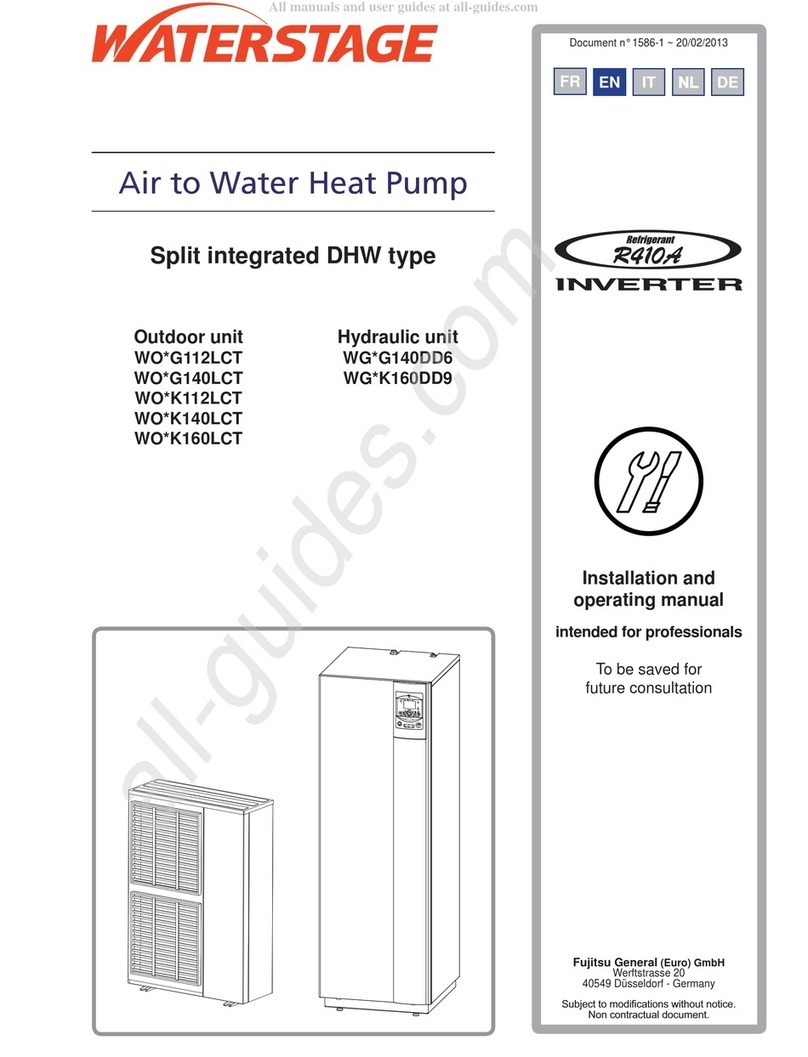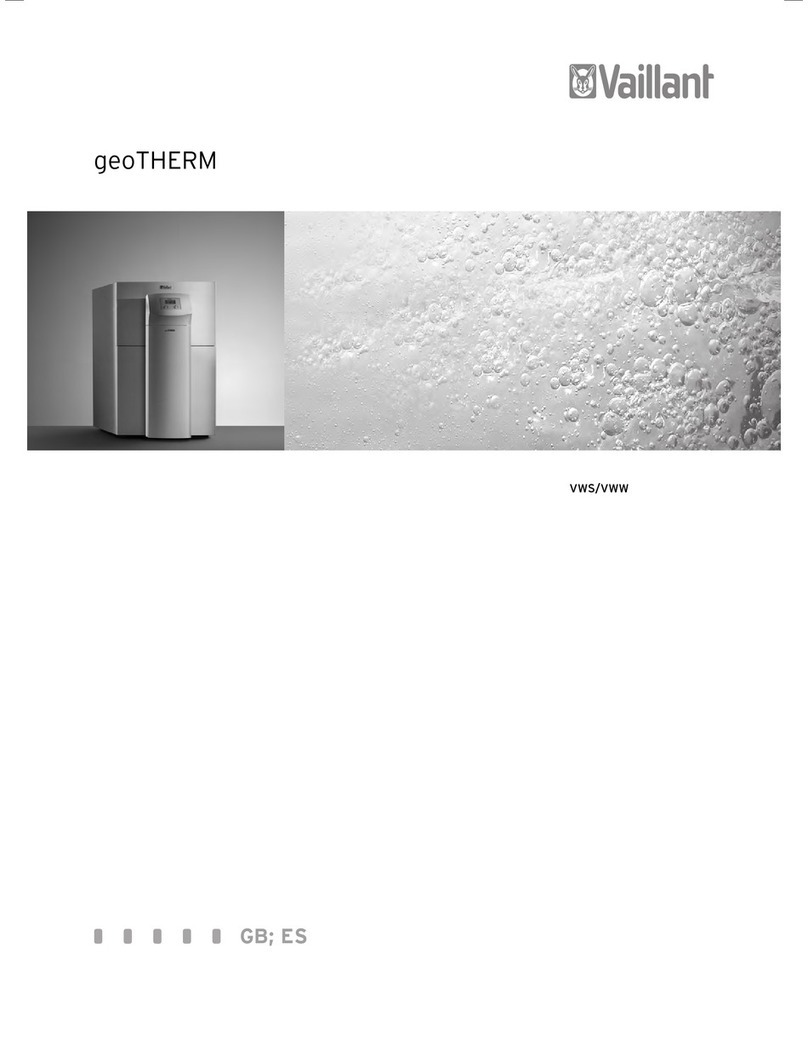NHP XTerra Series Manual

XTERRA SERIES
Horizontal and Vertical,
Single and Dual Stage Geothermal Heat Pumps:
FORCAIR
AQUA2
SOURC3
TERRA SERIES
ENERGY EXTRACTION SYSTEM
TABLE OF CONTENTS
Serial Number Breakdown 2
Model Descriptions 2
Physical Data & Dimensions 3
General Information 6
Closed Loop Applications 7
Open Loop Applications 10
HydronicHeat 12
Storage Tanks 13
Electrical 16
Thermostats 17
Desuperheater 21
StartUp 23
Troubleshooting 24
Warranty 26
INSTALLATION
And Maintenance Manual
NORTHERN HEAT PUMP
XTERRA SERIES
Horizontal and Vertical,
Single and Dual Stage Geothermal Heat Pumps:
FORCAIR
AQUA2
SOURC3
TABLE OF CONTENTS
Serial Number Breakdown 2
Model Descriptions 2
Physical Data & Dimensions 4
General Information 7
Closed Loop Applications 8
Open Loop Applications 11
Hydronic Heat 13
Storage Tanks 14
Electrical 17
Thermostats 18
Desuperheater 22
StartUp 24
Troubleshooting 25
Warranty 27

TERRA SERIES
ENERGY EXTRACTION SYSTEM
Page 2
MODEL # DESCRIPTION
SERIAL # DESCRIPTION
XL 08 01 A 1000 A
BILL OF MFG
YEAR OF MFG
MONTH OF MFG
MFG LOCATION
A=SOUTH RAILWAY PLANT
SEQUENTIAL NUMBER
FUTURE USE
A=LINE NUMBER
RA VE 502 - C 1 3 1
UNIT DESIGNATION
R=RESIDENTIAL
UNIT TYPE
A=STANDARD
M=MULTI
D=DUAL COMPRESSOR
S=SPECIAL
W=HEAT ONLY
T=TWO SPEED
P=MINI
UNIT STYLE
W=HYDRONIC
V=VERTICAL
D=DOWNFLOW
H=HORIZONTAL
S=SPLIT
REFRIGERANT TYPE
E=R410A REFRIGERANT
F=R22 REFRIGERANT
NORMAL SIZE
X 1000 BTU/H
DESUPERHEATER OPTION
1=NONE
2=PARTIAL DESUPERHEATER
3=FULL TIME
BLOWER TYPE
1=None
2=Standard PSC 3 Speed Blower
3=ECM Blower
CONFIGURATION
1=LEFT SIDE RETURN (STD)
2=RIGHT SIDE RETURN
3=NONE
HEAT EXCHANGER
C=COPPER
F=S.S. FLATPLATE
H=CUPRO HYDRONIC LOOP
N=CUPRO NICKEL
RESIDENTIAL MODEL # DESCRIPTION
POWER SUPPLY
1=208/230V 1Ph
2=208/230V 3Ph
3=575V 3Ph
4=460/480V 3PH
5=220/240V 1PH 50HZ
6=380V 3PH 50HZ

Page 3
SERIAL # DESCRIPTION
XL 08 01 A 1000 A
BILL OF MFG
YEAR OF MFG
MONTH OF MFG
MFG LOCATION
A=SOUTH RAILWAY PLANT
SEQUENTIAL NUMBER
FUTURE USE
A=LINE NUMBER
CD WE 114 2 - C 1 1
UNIT DESIGNATION
C=COMMERCIAL
UNIT TYPE
A=STANDARD
M=MULTI
D=DUAL COMPRESSOR
S=SPECIAL
W=HEAT ONLY
T=TWO SPEED
P=MINI
UNIT STYLE
W=HYDRONIC
V=VERTICAL
D=DOWNFLOW
H=HORIZONTAL
S=SPLIT
REFRIGERANT TYPE
E=R410A REFRIGERANT
F=R22 REFRIGERANT
NORMAL SIZE
X 1000 BTU/H DESUPERHEATER OPTION
1=NONE
2=PARTIAL DESUPERHEATER
3=FULL TIME
BLOWER TYPE
1=None
2=Standard PSC 3 Speed Blower
3=ECM Blower
HEAT EXCHANGER
C=COPPER
F=S.S. FLATPLATE
H=CUPRO HYDRONIC LOOP
N=CUPRO NICKEL
COMMERCIAL MODEL # DESCRIPTION
POWER SUPPLY
1=208/230V 1Ph
2=208/230V 3Ph
3=575V 3Ph
4=460/480V 3PH
5=220/240V 1PH 50HZ
6=380V 3PH 50HZ

XTerra Physical Data - R22
MODEL RA*F36 RA*F48 RA*F61 RA*F68
Compressor -1 Each SCROLL
Factory Charge R22 -(oz) 72 80 88 96
PSC Fan Motor & Blower
Fan Motor Type/Speeds PSC/3 PSC/3 PSC/3 PSC/3
Fan Motor HP 0.5 0.5 0.75 0.75
Blower Wheel Size Dia. x W 9x9 9x9 10x10 10x10
ECM Fan Motor & Blower –OPTIONAL
Fan Motor Type ECM ECM ECM ECM
Fan Motor HP 0.5 0.5 0.75 1.0
Water Connection Size
Residential Class 3/4” 3/4” 3/4” 3/4
HWG Water Connection Size
Residential Class 3/4” 3/4” 3/4” 3/4”
FORCAIR/SOURC3 Vertical (Upflow and Downflow)
Air Coil Dimensions H x W 20x20 20x20 20x28 20x28
Air Coil Total Face Area ft2 2.7 2.7 3.8 3.8
Air Coil Tube Size (in) 3/8 3/8 3/8 3/8
Air Coil Fin Spacing (fpi) 12 12 12 12
Air Coil Number of Rows 5 5 5 5
Filter Standard 1” Disposable 20x24 20x24 22x30 22x30
Filter Optional Electrostatic 1” 20x24 20x24 22x30 22x30
Weight– Packaged (lbs) 280 330 375 395
Width of Cabinet 28” 28” 28” 28”
Height 53” 53” 53” 53”
Depth 27” 27” 27” 27”
Horizontal
Air Coil Dimensions HxW 20x20 20x20 20 x 28 20 x 28
Air Coil Total Face Area ft2 2.7 2.7 3.8 3.8
Air Coil Tube Size (in) 3/8 3/8 3/8 3/8
Air Coil Fin Spacing (fpi) 12 12 12 12
Air Coil Number of Rows 5 5 5 5
Filter Standard 1” Disposable 20x24 20x24 22x30 22x30
Filter Optional Electrostatic 1” 20x24 20x24 22x30 22x30
Weight– Packaged (lbs) 290 340 380 400
Width of Cabinet 26” 26” 26” 26”
Height 25” 25” 25” 25”
Depth 58” 58” 58” 58”
AQUA2 Hydronic
Width of Cabinet 27” 27” 27” 27”
Height 25.5” 25.5” 25.5” 25.5”
Depth 28” 28” 28” 28”
Weight– Packaged (lbs) 200 220 235 255
All units have rubber compressor mountings and thermostatic expansion valves.
Data Subject To Change Without Notice.
Page 4

Page 5
XTerra Physical Data - R410A SINGLE STAGE COMPRESSOR
MODEL RA*E36 RA*E50 RA*E57 RA*E70
Compressor -1 Each SCROLL
Factory Charge R22 -(oz) 72 80 88 96
PSC Fan Motor & Blower
Fan Motor Type/Speeds PSC/3 PSC/3 PSC/3 PSC/3
Fan Motor HP 0.5 0.5 0.75 0.75
Blower Wheel Size Dia. x W 9x9 9x9 9x9 10x10
ECM Fan Motor & Blower –OPTIONAL
Fan Motor Type ECM ECM ECM ECM
Fan Motor HP 0.5 0.5 0.75 1.0
Water Connection Size
Residential Class 3/4” 3/4” 3/4” 3/4
HWG Water Connection Size
Residential Class 3/4” 3/4” 3/4” 3/4”
FORCAIR Vertical (Upflow and Downflow)
Air Coil Dimensions H x W 20x20 20x20 20x28 20x28
Air Coil Total Face Area ft2 2.7 2.7 3.8 3.8
Air Coil Tube Size (in) 3/8 3/8 3/8 3/8
Air Coil Fin Spacing (fpi) 12 12 12 12
Air Coil Number of Rows 5 5 5 5
Filter Standard 1” Disposable 20x24 20x24 22x30 22x30
Filter Optional Electrostatic 1” 20x24 20x24 22x30 22x30
Weight– Packaged (lbs) 280 330 375 395
Width of Cabinet 28” 28” 28” 28”
Height 53” 53” 53” 53”
Depth 27” 27” 27” 27”
Horizontal
Air Coil Dimensions HxW 20x20 20x20 20 x 28 20 x 28
Air Coil Total Face Area ft2 2.7 2.7 3.8 3.8
Air Coil Tube Size (in) 3/8 3/8 3/8 3/8
Air Coil Fin Spacing (fpi) 12 12 12 12
Air Coil Number of Rows 5 5 5 5
Filter Standard 1” Disposable 20x24 20x24 22x30 22x30
Filter Optional Electrostatic 1” 20x24 20x24 22x30 22x30
Weight– Packaged (lbs) 290 340 380 400
Width of Cabinet 26” 26” 26” 26”
Height 25” 25” 25” 25”
Depth 58” 58” 58” 58”
AQUA2 Hydronic
Width of Cabinet 27” 27” 27” 27”
Height 25.5” 25.5” 25.5” 25.5”
Depth 28” 28” 28” 28”
Weight– Packaged (lbs) 200 220 235 255
All units have rubber compressor mountings and thermostatic expansion valves.
Data Subject To Change Without Notice.

Page 6
XTerra Physical Data - R410A DUAL STAGE COMPRESSOR
MODEL RT*E30 RT*E40 RT*E51 RT*E60
Compressor -1 Each SCROLL
Factory Charge R22 -(oz) 72 80 96 96
PSC Fan Motor & Blower
Fan Motor Type/Speeds PSC/3 PSC/3 PSC/3 PSC/3
Fan Motor HP 0.5 0.5 0.5 0.75
Blower Wheel Size Dia. x W 9x9 9x9 9x9 10x10
ECM Fan Motor & Blower—OPTIONAL
Fan Motor Type ECM ECM ECM ECM
Fan Motor HP 0.5 0.5 0.5 0.75
Water Connection Size
Residential Class 3/4” 3/4” 3/4” 3/4
HWG Water Connection Size
Residential Class 3/4” 3/4” 3/4” 3/4”
FORCAIR/SOURC3 Vertical (Upflow and Downflow)
Air Coil Dimensions H x W 20x20 20x20 20x28 20x28
Air Coil Total Face Area ft2 2.7 2.7 3.8 3.8
Air Coil Tube Size (in) 3/8 3/8 3/8 3/8
Air Coil Fin Spacing (fpi) 12 12 12 12
Air Coil Number of Rows 5 5 5 5
Filter Standard 1” Disposable 20x24 20x24 22x30 22x30
Filter Optional Electrostatic 1” 20x24 20x24 22x30 22x30
Weight– Packaged (lbs) 280 330 375 395
Width of Cabinet 28” 28” 28” 28”
Height 53” 53” 53” 53”
Depth 27” 27” 27” 27”
Horizontal
Air Coil Dimensions HxW 20x20 20x20 20 x 28 20 x 28
Air Coil Total Face Area ft2 2.7 2.7 3.8 3.8
Air Coil Tube Size (in) 3/8 3/8 3/8 3/8
Air Coil Fin Spacing (fpi) 12 12 12 12
Air Coil Number of Rows 5 5 5 5
Filter Standard 1” Disposable 20x24 20x24 22x30 22x30
Filter Optional Electrostatic 1” 20x24 20x24 22x30 22x30
Weight– Packaged (lbs) 290 340 380 400
Width of Cabinet 26” 26” 26” 26”
Height 25” 25” 25” 25”
Depth 58” 58” 58” 58”
AQUA2 Hydronic
Width of Cabinet 27” 27” 27” 27”
Height 25.5” 25.5” 25.5” 25.5”
Depth 28” 28” 28” 28”
Weight– Packaged (lbs) 200 220 235 255
All units have rubber compressor mountings and thermostatic expansion valves.
Data Subject To Change Without Notice.

GENERAL INFORMATION
XTERRA Series Geothermal heat pumps are designed to
provide maximum efficiency and reliability. Solid and simple
electric controls allow for low maintenance and built in safety
protection. When properly installed and maintained you can
trust Northern Heat Pump.
Page 7
VERTICAL UNIT LOCATION AND MOUNTING
Locate the unit in an indoor area where the ambient
temperature will remain above 7°C. NHP provides 3
removable panels for ease of servicing; front, right and rear
side. Allow enough room to remove panels and for filter
maintenance. Units should be mounted on a vibration
absorbing pad (rubber or extruded polystyrene) slightly
larger than the base to provide isolation between the floor
and the unit. (figure # 1) Water supply should not be hard
plumbed directly with copper pipe as this could transfer any
vibration to living space.
VERTICAL CONDENSATE DRAIN
Vertical FORCAIR and SOURC3 units must have a
condensate drain installed to remove moisture from the
evaporating pan when air conditioning. Vertical forced air
models have an internal trap built into the unit. The
connection must satisfy local plumbing codes. To ensure
free condensate flow the drain line must slope away from
the unit.
Install the condensate drain line into an open drain. (Figure
# 1)
MOVING AND STORAGE
Units should be stored in original packaging in a clean dry
area. Store and move units in normal upright position. Do
not stack units.
SAFETY
Service of refrigerant based equipment can be hazardous
due to system pressure and high voltage electrical energy.
Only trained and qualified service personnel can install,
repair or service refrigerant equipment. The installation
must meet all local electric, plumbing, heating and air
conditioning codes.
WARNING:
Turn off the main switches before performing
service or maintenance to this unit. Electric
shock can cause personal injury.
3/4 FPT Condensate
Drain
Slope away from
unit
Rubber pad
or extruded
polystyrene
HORIZONTAL MOUNTING
Horizontal units may be mounted on any surface that
can support their weight. Typically they are
suspended by threaded rods attached to the unit by
using corner hanging brackets (See Figure # 2).
If the unit is set on an attic floor or similar situation, an
anti-vibration pad similar to the vertical units should be
used to help isolate any noise. All installations should
conform to local codes. Allow enough space to
access electrical panels, compressor compartment
and filter rack.
Figure # 2Figure # 1
INITIAL INSPECTION
Be certain to inspect all cartons and crates as units
are received before signing the freight bill. Verify that
all items received have no physical damage. Report
any damages or shortages on the freight bill. The
purchaser is responsible for filing the necessary
claims with the carrier. Concealed or hidden damages
not discovered until removing packaging must be
reported to the carrier within 15 days of receipt.

WARNING:
Before driving screws into the cabinet check on the inside
of the unit to make sure the screws will not hit any
electrical or refrigeration lines.
HORIZONTAL CONDENSATE DRAIN
Horizontal units are not internally trapped: An
external trap is required. Two drain connections are
located at the radiator end of the cabinet. Use either
connection and plug the remaining connection. Each
unit must also include its own vent for condensate.
(Figure # 3)
The condensate drain incorporates a 3/4” FPT port.
A drain line attached to this port must slope away from
unit and must be properly vented.
Horizontal units should be pitched slightly towards the
drain end by minimum 1/4” to help condensate drain.
DUCTING SYSTEM
All XTERRA Series models include a return duct air
flange and filter rack. Both return and supply ducts
should be isolated with a flexible connection to
minimize vibration transfer to the ducting.
To further reduce noise, both return and supply duct
can be internally insulated the first few feet with duct
board.
Note: Undersized ducting on new or retrofitted
systems can not only increase air noise, it can affect
heat transfer to the building and unit performance.
Size duct to appropriate blower outputs and
building needs.
ELECTRICAL
All electrical and wiring must comply with local code.
Power supplied to the unit must be within the
operating range on the unit’s description and rating
plate.
Condensate Drain
Vent
Slope away
from unit
Condensate Trap
3” drop
Figure # 3
Horizontal
Unit
Page 8
CLOSED LOOP APPLICATIONS
A closed loop system re-circulates the same water/
antifreeze solution through a closed system of under-
ground high-density polyethylene pipe. As the solution
passes through the pipe it collects heat (in the heating
mode) that is being transferred from the relatively warm
surrounding soil through the pipe and into the relatively
cold solution. The solution is circulated back to the heat
pump that extracts its heat and then returns to the
ground to absorb more heat from the earth.
The XTERRA Series heat pumps are designed to oper-
ate on either vertical or horizontal closed loop appli-
cations. ( Figures 4 & 5 ) Vertical loops are typically in-
stalled with a well drilling rig up to 200 feet deep or more.
Horizontal systems are typically installed with excavating
or trenching equipment approximately six to eight feet
deep, depending on geographic location and length of
pipe used. Earth loops must be sized properly for each
particular geographic area and individual capacity re-
quirements. Contact your local installer for loop sizing
requirements in your area.
Vertical Loop
Figure #5
Figure #4
Horizontal Loop
Once closed loops are completed, they must be pressure
tested to ensure integrity.
Once pressure is tested, loop must be purged of all foreign
debris and filled with fluid. All air must be removed at this
time by flushing the system.
Table # 1 shows approximate fluid volumes:

DO NOT Mix more than 25% propylene glycol with water
to achieve a lower than –9°C freeze protection. (See Table
#2) A more concentrated mixture cannot be pumped through
the earth loop at low temperatures. Lack of antifreeze will
cause unit shutdown problems during cold weather
operation (longest unit run time) when the loop temperatures
fall below the freeze protection of the antifreeze. Flow rate
requirements for closed loop solutions are higher than open
loop systems because water temperatures supplied to the
heat pump are generally lower. Typically 2.0 to 3.0 gallons
per minute (GPM) per ton are required for proper
operation of the heat pump and the earth coupled heat
exchanger.
WARNING:
Do NOT use calcium as anti-freeze. Follow IGSHPA
recommendations for the appropriate type and
amount of anti-freeze.
Antifreeze Percentages by Volume
Methanol
25%
21%
18%
16%
10%
100% USP Food Grade
Propylene Glycol
38%
30%
25%
22%
15%
Ethanol 22%
20% 18% 14% 10%
Minimum Temp. for Freeze Protection
-12°C -9°C -8°C -6°C -4°C
Type (10°F) (16°F) (17°F) (21°F) (25°
F)
Table #2
Pipe Size Volume
Polyethylene 3/4” IPS SDR 11 2.8
1” IPS SDR 11 4.5
1-1/4” IPS SDR 11 8.0
1-1/2” IPS SDR 11 10.9
2” IPS SDR 11 18.0
Rubber Hose 1” 3.9
Copper 1” 4.1
1.25” 6.4
1.5” 9.2
Table #1
Approximate Fluid Volume (gal) per 100” of pipe
LOOP PUMP SELECTION
Select a loop circulation pump based upon the gpm
required and total system pressure drop.
Refer to Table # 3.
Pressure/Temperature (P/T) plugs should be installed in
the adaptor elbow on the entering and leaving water line of
the heat pump on a closed system (Figure# 6) A
thermometer can be inserted into the P/T ports to check
entering and leaving water temperatures. A pressure
gauge can also be inserted into these P/T ports to
determine the pressure differential between the entering
and leaving water. This pressure differential can then be
compared to the engineering specifications data to
determine the flow rate of the system.
1” Brass Barb
Heat Pump Adaptor Elbow
P/T Port Plug
3/4 MPT
Figure # 6
Unit LOOP PD PD
Size GPM (FT) (PSI)
3 Ton 4.0 2.7 1.2
8.0 11.3 4.9
4 Ton 6.0 6.2 2.7
11.0 24.2 10.5
5 Ton 8.0 11.5 5.0
13.0 34.6 15.0
6 Ton 10.0 19.6 8.5
14.0 45.7 19.8
Data and specifications may change without notice
Heat Exchanger Pressure Drop
Table # 3
LAKE OR POND LOOPS
Closed loop systems may also be used in lakes or rivers to
supply a heat source to the heat pump.
Typically a loop consisting of geothermal pipe can be
designed and placed in an area not much deeper than 15ft
with some water currents present. In any lake or pond,
municipal and area by-laws must be observed in regards to
a lake or pond loop. The use of an environmentally friendly
loop fluid like ethanol should be considered if the loop was
ever damaged. Consult a IGSHPA certified installer for
proper lake or pond loop design.
WARNING:
Loop design is extremely important for proper heat pump operation. Incorrect loop design will
reduce heat pump efficiency, cause poor performance OR may render the loop unusable. Contact a
IGSHPA certified geothermal loop contractor for proper installations.
Page 9

FLUSHING AND FILLING THE SYSTEM USING 3 WAY
VALVES
Step 1
Use water and a high volume head circulator pump to flush
air and debris and to fill the loop system.
- Refer to recommendations provided by IGSHPA when
choosing a pump for the flushing process.
- It is recommended that pump suction be from the bottom
of a large volume container. Use a suction line strainer to
prevent debris discharged into the container from being
recycled to the system.
Step 2
Pump water into the system by connecting the pump
discharge hose to one (not both) of the 1” NPT water
connections located on the sides of the module.
Connect a return hose to the opposite side of the module to
discharge debris and air as water is added to the loop.
Step 3
Rotate the module valves as shown in step 3 diagram:
Step 4
Start the pump. Add anti-freeze and water to the container
as needed so that no air enters the system. This will push
any air out of the loop. If flushing assembly is equipped with
valves to reverse flow direction, do so occasionally to help
remove trapped air. When bubbles cease in the return hose
container, the earth loop has been completely flushed.
Step 5
Flush the heat pump. To do so, simply rotate the valves as
shown in step 5 diagram while the pump is running. Flush
the heat pump using the same procedure as used to flush
the earth loop.
Pressurizing The System
Step 6
After flushing and filling the system, rotate the module valve
discharging into the flush container as shown in step 6A
diagram to pressurize the loop. Then turn the valves as in
step 6B.
Step 7
Turn off the flush cart pump. The system should remain
pressurized. Release excess pressure by rotating either
module valve to allow a small amount of water to pass
through and out of the system and into the container. Some
initial loss of pressure can be expected and is due to the
expansion of the earth loop pipe under pressure. The
pressure will stabilize if the system has no leaks.
Step 8
Flushing, filling and pressurization should be complete.
Start the loop pump module circulators.
Page 10
To Earth Loop From Earth Loop
From
Flush
Cart
To
Flush
Cart
Step 3
From Heat PumpTo Heat Pump
Step 5 To
Flush
Cart
From
Flush
Cart
Step 9
Troubleshoot. If for some reason the circulators are not
operating, power off and diagnose the problem.
Step 10
Using a single water pressure gauge, measure the pressure
drop at the pressure/temperature plugs across the heat
pump heat exchanger. Compare the measurement with the
flow versus the pressure drop table (Table#3) and determine
the actual flow rate. If the flow rate is low, recheck the
selection of the loop pump module model for sufficient
capacity. If the model is correct, there is likely trapped air or
a restriction in the flow circuit.
System pressure should increase rapidly as the flush pump
works to force more water into the system. Additional
flushing of the loop is needed if the water level in the loop
falls. This shows that there is air in the system.
System operating pressures should be between 10 to 40
PSI.
From Heat Pump To Heat Pump
To Earth Loop From Earth Loop
Step 6B
From Heat PumpTo Heat Pump
Step 6A
From
Flush
Cart
Pressurize Loop

OPEN SYSTEM APPLICATIONS
An open system gets its name from the open discharge of
water after it has been used by the heat pump. A well must
be available that can supply all of the water requirements of
the heat pump along with any other water requirements
drawing off that same well. The well must be capable of
supplying the heat pumps required flow rated for up to 24
hours per day for the coldest winter day.
Figure # 7 shows the necessary components for water
piping of an open system. First a bladder type pressure tank
with a “draw down” of at least 1-1/2 to 2 times the well pump
capacity must be installed on the supply side of the heat
pump to prevent short cycling the well pump. Shut off
valves and boiler drains on the entering and leaving water
lines are necessary for future maintenance. A screen
strainer is placed on the supply line with a mesh size of 40
to 60 and enough surface area to allow for particle buildup
between cleanings. Pressure temperature (P/T) plugs are
placed in the supply and discharge lines so that
thermometers or pressure gauges can be inserted into the
water stream. On the well water discharge side of the heat
pump a flow control/shut off valve must be mounted to
regulate the maximum water flow through the unit. Remove
handle to prevent accidental change of flow.
A solenoid valve is then installed and wired to X & Y terminal
on the heat pump. (See page 15 in Electrical Section) This
valve will open when the unit is running and close when the
unit stops.
A visual flow meter is then installed to allow visual inspection
of the flow requirements. The flow meter can also be useful
in determining when maintenance is required. Schedule 40
PVC piping, copper tubing, polyethylene or rubber hose can
be used for supply and discharge water lines. Limit rubber
hose to 10ft. to prevent excessive pressure drop. Make sure
line sizes are large enough to supply the required flow with a
reasonable pressure drop (generally 1” diameter).
Water discharge is generally made to a drain field, stream,
pond, surface discharge, tile line, or storm sewer.
CAUTION: Using a drain field requires soil conditions and
adequate sizing to assure rapid percolation or the required
flow rates will not be achieved. Consult local codes and
ordinances to assure compliance. DO NOT discharge water
to a septic system. The heat pump should never be
operated with flow rates less than specified. Operation of
the unit with less than required flow rate or no flow may
result in freezing water in the water to refrigerant heat
exchanger. This will cause the unit to shut down on low-
pressure lockout. If the unit locks out, verify that the unit has
the required flow and reset the unit by shutting off power to
the unit for one minute. DO NOT continually reset the unit; if
the unit locks out more than once call your service
professional. Continued reset of the unit can freeze water
inside the water coil to the point of rupturing the water coil.
Open Loop Freeze Protection Switch
Heat pump installations on open loop systems, using a non-
antifreeze protected water source during the heating mode
require the use of a water coil freeze protection switch. If
the water supply to the heat pump is interrupted for any
reason, continued operation of the compressor will cause
the water remaining in the water-to-refrigerant heat
exchanger to freeze and rupture. The freeze protection
switch (low pressure switch) will shut the unit down before
freezing can occur and protect the heat pump against flow
loss and damage.
Water Coil Maintenance
Water quality is a major concern for open systems.
Problems can occur from scaling, particle buildup,
suspended solids, corrosion, pH levels outside the 7-9
ranges, or biological growth. If poor water quality is known
to exist in your area a cupro-nickel water coil may be
required when ordering the system, or installing a closed
loop system may be the best alternative. Water coil
cleaning on an open loop system may be necessary on a
regular basis.
Page 11
Figure # 7 Open System Diagram
Expansion Tank/Water Supply Strainer
Shut Off
Valves
Boiler Drains
Visual Flow meter
Solenoid
Shutoff
Valve
Supply Return Well
In
Out
Adaptor Elbow
With PT Plugs

Page 12
Depending on the specific water quality issue, the water
coil can be cleaned by the following methods:
Chlorine Cleaning (Bacterial Growth)
1. Turn thermostat to “Off” position.
2. Connect a circulating pump to hose bibs on entering
water and leaving waterside of heat exchanger.
3. Using a five-gallon pail of water add chlorine bleach
mixture. The chlorine should be strong enough to kill
the bacteria. Suggested initial mixture is 1 part
chlorine bleach to 4 parts water.
4. Close shut off valves upstream and downstream of heat
exchanger.
5. Open hose bibs to allow circulation of bleach solution.
6. Start pump and circulate solution through heat
exchanger for 15 minutes to one hour. Solution should
change color to indicate the chlorine is killing the
bacteria and removing it from the heat exchanger.
7. Flush used solution down the drain by adding fresh
water supply. Flush until leaving water is clear.
8. Repeat procedure until solution runs clear through the
chlorine circulation process.
9. Flush entire heat pump system with water.
This procedure can be repeated annually,
semiannually, or as often as it takes to keep bacteria
out of the heat exchanger, or when bacteria appears in
a visual flow meter to the point the flow cannot be
read.
Miradic Acid Cleaning
(Difficult Scaling and Particle Buildup Problems)
Consult installer due to dangerous nature of
acids.
Iron out solutions and de-scaling products are also useful.

HYDRONIC HEAT EXCHANGE
Radiant Floor Heating
Hydronic side heat exchangers can be a variety of different
types. Probably the most popular form of hydronic heat
exchanger is radiant floor heat tubing. Radiant floor heating
gives excellent comfort and very high efficiencies by
supplying low temperature water to the floor slab and
keeping the heat concentrated evenly near the floor.
Radiant floor heating systems heat the occupants and
surfaces directly with radiant energy not by heating air that
transfers the heat to the occupants.
Radiant floor heating usually consists of tubing laid in the
slab. The amount and spacing of the tubing is calculated to
meet the capacity of the space being heated. To optimize
the efficiency, the fluid temperature inside the tubing should
be maintained as low as possible. The type of floor covering
and the spacing of the pipe in the floor have the greatest
effect on operating fluid temperature.
NHP designs its hydronic heat pump line using a
46°C (115°F) leaving water design point. This leaving water
temperature is the ideal maximum fluid temperature for
radiant floor systems. Operating temperatures higher than
this would result in less efficient operation and possibly an
uncomfortable condition.
High static pressure fan coils work well with hydronic heat
pumps. These systems, produced by Unico System, Space
Pak and others, provide heating and cooling for houses
without ductwork. They use a high static pressure blower to
supply air through small diameter chase ways to the living
space. The blower passes through a water-to-air coil which
is coupled to a water-to-water heat pump to provide heating
and cooling. These systems work nicely on retrofit
applications where ductwork isn’t available or wanted.
When sizing the fan coil, keep in mind maximum
recommended water temp. LWT 46°C (115°F) . However,
running the heat pump continuously will result in very high
operating pressure and may shorten the life of the unit.
Base Board Heating
Cast iron radiators have been used successfully. If these
radiators are rated for an output of 70 Btuh/square inch at
130°F the system should still operate at the standard 115°F
HYD LWT of the water-to-water heat pump. Some
installations may require additional use of an air handler or
more aggressive finned tube to provide enough heat during
the colder weather.
Other Applications
Open loop hydronic applications (Figure # 8)such as
outdoor swimming pools, hot tubs, whirlpools, tank heating,
etc. are easily sized and based on heat exchanger operating
temperature and flow. Often sizing a heat pump to these
applications comes down to recovery time; the larger the
heat pump (within reason to avoid short cycling), the faster
the system recovery time. Note: Installing a plate heat
exchanger between the heat pump and an open system is
required when corrosive fluid is used in the open loop,
especially on swimming pools where pH imbalance can
damage the heat pump.
Other forms of closed loop systems such as indoor
swimming pools, pretreated fresh air systems, snow melt,
and valance heating/cooling systems are also very common
with water-to-water heat pumps. The sizing of the heat
pump to these systems is more precise and information from
the system manufacture is required. Note: Expect the
maximum operating temperature of an indirect coupled
application to be approximately 12°C below the maximum
operating temperature of the heat pump.
Systems must be constructed to all appropriate codes and
according to accepted plumbing practices.
Should NHP heat pumps be installed in an industrial
application in Europe, the unit will be “fitted with means for
disconnection from the supply mains having a contact
separation in all poles that provide full disconnection under
overvoltage category III, the instructions state that means for
disconnection must be incorporated in the fixed wiring in
accordance with the wiring rules” in Europe.
Fan Coils
Fan coils can be used with NHP hydronic AQUA2 heat
pumps in the heating and cooling mode. In many cases
radiant floor heating and fan coil cooling are used together.
Fan coils also provide dehumidification. Dehumidification
rates can be adjusted by varying the fan coil operating
temperature and air flow.
Fan coils are available in many different sizes and
configurations making them very flexible to your particular
application. Note: When selecting fan coil units for cooling
use, make sure they include condensate drain pans.
Fan coils are sized for capacity at specific water temperature
and flow rate combinations. Their sizing is also based on air
temperatures, airflow rates (which remain constant based on
fan speed selection and static pressure differential), and
humidity conditions. The fan coils are then matched to the
heat pump at a common system flow rate and operating
temperature to provide the overall system capacity to a
space load.
Page 13

In
Out
Supply
Earth Heat Exchanger
Pump Module
SOURC3
Individual Zones
Heat Load
Zone Supply Valves
Zone Return Lines
Pump
Expansion Tank
Hydronic
Hot Water
Storage
Tank
Figure # 8
Pump
Conceptual Drawing Only
STORAGE TANKS
Coupling the heat pump to the space conditioning heat
exchanger through a water storage tank is recommended
(Figure # 9). In fact, the only instance where these storage
tanks are not recommended, is when the heat pump is
coupled to a large heat exchanger capable of absorbing the
entire heating or cooling capacity of the heat pump
requiring high discharge water temperatures. Insulated hot
water heaters are commonly used for storage tanks.
Individual Zones
Heat Load
Zone Supply Valves
Zone Return Lines
Pump
Expansion Tank
Hydronic Hot
Water
Storage
Tank
Figure # 9
Heat
Pump
Pump
Conceptual Drawing Only
In applications that use multiple smaller zones,
storage tanks absorb the relatively large amount of
energy supplied by the compressor to provide longer
run times and less compressor cycling for the heat
pump. Storage tanks also serve to dispense energy in
small amounts so that the conditioned zones have
time to absorb heat without short cycling.
When properly sized, a storage tank eliminates many
problems with multiple zone hydronic systems. These
problems include;
1) Excessive leaving water temperature if a single
zone cannot dissipate heat quickly enough.
2) Flow reduction through the heat pump when only
one zone is calling which can occur because the
pump is normally sized to provide the heat pumps
required flow with all zones calling. When sizing
storage tanks to the heat pump, a good rule of
thumb is 10 gallons of storage tank per ton of
hydronic capacity.
The tank temperature can be controlled with a simple Aqua
stat or a set point controller.
CAUTION
For proper operation adequate water flow must be
achieved through heat pump heat exchangers.
Page 14

CIRCULATION FLUID
The fluid circulating through the hydronic side of the
geothermal heat pump system is the transfer medium for
the heating and cooling being supplied to the conditioned
space. Selection of this fluid is very important. Water is
the most readily available fluid but has the draw back of
expansion during freezing which can damage the system.
Antifreeze must be used wherever the possibility of
freezing exists from the environment or from use of the unit
in the cooling mode. A propylene glycol based antifreeze
and water solution is recommended. Freeze protection for
the hydronic side fluid down to –7 degrees Celsius (20%
propylene glycol) by volume in water is recommended for
most indoor applications.
(Table # 4) Using over 40% solution in hydronic side
applications can cause pumping problems due to high
viscosity.
The water being added to the system should have 100
PPM grains hardness or less. If poor water conditions exist
on the site, softened water is recommended, or acceptable
water should be brought in. Bacteria or algae’s growth in
the water is a possibility, especially bacteria or algae that
thrive at the particular temperatures produced in the
heating system. This growth can cause buildup on hydronic
side heat exchanger surfaces reducing the efficiency of the
system or causing the heat pump to run at higher head
pressures and cut out.
EXPANSION TANKS
Expansion tanks must be used in the hydronic side of the
water-to-water system to absorb the change in pressure of
the closed system due to the change in temperature when
heat is supplied to the system. Diaphragm-type expansion
tanks should be used. The diaphragm in these tanks is filled
with pressurized air which expands or contracts to maintain
constant overall system pressure as the fluid in the system
expands with increasing temperature. Use diaphragm tanks
that are compatible with glycol-based antifreeze fluids (butyl
rubber diaphragms will slowly dissolve with glycol-based
antifreezes). Expansion tanks should be installed in the
system near the suction of the circulator whenever possible.
This maintains positive pressure at the circulator and
reduces the highest working pressure of the system.
Antifreeze Percentages by Volume
Methanol
25%
21%
18%
16%
10%
100% USP Food Grade Propylene Glycol
38%
30%
25%
22%
15%
Ethanol 22%
20% 18% 14% 10%
Type Minimum Temp. for Freeze Protection
-12°C -9°C -8°C -6°C -4°C
(10°F) (16°F) (17°F) (21°F) (25°F)
Table # 4
HYDRONIC SIDE CIRCULATORS
Hydronic circulator pumps transfer the energy supplied by
water-to-water heat pumps to the space conditioning
exchanger. (Figure # 11) When selecting a circulator be
sure to select a pump with the ability to supply the required
flow rate at the system pressure drop. The circulator
supplying the heat pump should be placed in the water
supply line entering the unit to provide the best pump
performance. Individual zone pumps should also be
installed in the supply line to the heated zones.
Small circulator pumps can be used. If these pumps are
impedance protected they do not require additional fusing if
powered directly from the heat pump. If impedance
protected pumps are not used, inline fuses should be
supplied according to code.
A common problem with circulator pumps is trapped air in
the system. This air accumulates in the suction port of the
circulator pump causing cavitations in the pump that leads
noisy operation and premature pump failure. Air can be
eliminated by completely purging the system or by placing
an air separator in the plumbing lines.
The entire system must be purged of air during initial
installation and pressurized to a 20 to 30 psi static pressure
to avoid air entering the system. This initial static pressure
may fluctuate when going from the heating to cooling modes
but should always remain above zero. If a leak in the
system allows the static pressure to drop, the leak must be
repaired to assure proper system operation. If air
continually enters the loop; corrosion, bacteria, or pump
cavitations may occur.
The hydronic side circulator supplying the heat pump should
be controlled to run only when the heat pump is also
running.
Page 15

ELECTRICAL SERVICE
The main electrical service should be fusible and capable of
providing the amperes required by the unit at nameplate
voltage. All wiring shall comply with the national electrical
code and/or any local codes that may apply. Access to the
line voltage contactor is gained through the electrical
knockouts provided on either sides of the heat pump next to
the front corner.
WARNING: The unit must be properly grounded!
WIRING HYDRONIC PUMPS
When supplying water pumps off the system power supply,
use impendence protected motors. The module can be
wired directly to the contactor and grounded in the
grounding lug. A relay (RP) and terminal block (BP) are
supplied in the electrical box for the hydronic side pumps.
The relay will start the pump with a call from the aqua stat
on SOURC3 units. The pump relay is activated by power to
G on the terminal strip (BT) of hydronic units (wire G to X).
The use of impedance-protected pumps eliminates the need
for additional fusing. Do not connect more than a 1/3-horse
power pump to the internal pump relay.
If larger pumps are required or impedance protected pumps
are not used, a separate power supply is required. To start
this pump use a 24-volt relay controlled from the Y and X
terminals.
24-VOLT CONTROL CIRCUIT
Transformer
An electrical diagram is provided to operate all control
features of the heat pump. The transformer can be quickly
overloaded when using it for additional control equipment
like zone valves or fan coil relays.
On more complicated control systems transformer capacity
is used up quickly.
If the systems external controls require more than
40 VA of power from the transformer an external transformer
must be used. The heat pump’s transformer can generally
power simpler control systems consisting of a few relays or
zone valves (depending of course on the VA draw of the
components).
The SOURC3 heat pump requires at least two temperature
controls. The first is a forced air heat pump thermostat
connected directly to the terminal strip. This thermostat
controls forced air heating and cooling as any thermostat
would. The second control is a aqua stat, which is powered
from R on the terminal strip, through the aqua stat, and back
to H on the low voltage thermostat block in the heat pump.
ELECTRICAL
The aqua stat tells the heat pump when hydronic side water
heating is required and when the hydronic side is satisfied.
The SOURC3 combination heat pump can only run one
mode at a time (one thermostat must have priority over the
other). Any number or types of thermostats, aqua stats, or
switches can be used with an independent power supply
(typically a 24 volt transformer) to activate specific zone
controls. These zone controls are normally either a zone
pump or zone valves. End switches on the zone valves can
be used to pass a signal to a pump relay when the zone
valve is open. The pump relay then activates a common
pump, which supplies any number of zones.
NOTE: A common maximum aqua stat set point is
46°C (115°F). The tank will then shut down when it reaches
46°C however the leaving water temperature from the heat
pump is actually higher (near the maximum operating
temperature). The Aqua stat maximum set point should limit
the head pressure of the heat pump to 325 psi.
If the thermostat is equipped with an anticipator it should be
set to its lowest setting to avoid interfering with heat pump
operation.
Digital Timer
The timer performs the following functions which control the
compressor operation: system lockout, compressor anti-
short cycle, and a five minute delay after power is applied.
System lockout occurs if the high pressure and low pressure
switches open. The timer blocks the signal from the
thermostat to the contactor to energize the compressor.
This lockout condition means that the unit has shut itself
down to protect itself, and will not come back on until power
has been disconnected (circuit breaker) to the heat pump.
Problems that could cause a lockout situation include:
1. Water flow problems
2. Air flow problems
3. Internal heat pump operation problems
4. Cold ambient air temperature conditions
If a lockout condition exists, the heat pump should not be
reset more than once and a service technician should be
called immediately. The cause of the lockout must be
determined or repeated reset damage may occur to the
system.
The anti-short cycle function puts a time-out period of ten
minutes on the compressor before re-starting. This function
protects the compressor from repeated on/off operation in
the event of a loose wire or faulty controller.
Page 16

Page 17
SOURC3 Wiring Diagram Figure #12
FORCAIR Wiring Diagram Figure #11

Thermostat/Aqua stat
Consult the instructions in the thermostat box for proper
mounting and thermostat operation.
CAUTION:
Improper wiring of controls may result in transformer
burnout.
Power is supplied to the thermostat by connecting the R and
X terminals to the heat pump terminal strip. The Y terminal
energizes the compressor. The unit is put into the cooling
mode when the thermostat energizes the O terminal which
operates the reversing valve. A compressor lockout is
indicated by the L terminal, which is used to power the
lockout LED on a thermostat or an external 24-volt lockout
light.
On hydronic AQUA2 and SOURC3 units the pump relay (RP)
is connected to the circulation pump high voltage connection
block (BP). The hydronic side circulation pump receives
power from BP, which is energized by RP. Running a jumper
wire from Y to G on the terminal strip (BP) of a hydronic unit
will bring the circulation pump on seconds before the
compressor to prove water flow. The hydronic pump relay
(RP) on a SOURC3 unit energizes automatically when the
system runs in the hydronic mode.
Page 18
R
G
O
Y
W2A
W2
L
X
H
E
24 Volt Power
Fan
Reversing Valve
Compressor
Second Stage Auxiliary
Second Stage Electric
Lockout Indicator
Common
Hydronic (Sourc3)
Emergency Relay
Block Terminal – Thermostat
Block terminals have the following input functions:
AQUA2 Wiring DiagramFigure #13

Second Stage Duct Heater - SOURC3 Model
Since the SOURC3 model can run in either forced air mode
or hydronic mode, second stage must be wired through W2
and W2A as shown below:
Second Stage Duct Heater - FORCAIR Model
A second stage electric duct heater can be added in
conjunction with a XTERRA Series heat pump to help
supplement heat if required. This duct heater can also act
as an emergency backup if the heat pump should fault for
any reason.
A two stage thermostat is required to activate the second
stage. On a FORCAIR model heat pump, wire the second
stage as shown below:
A simple, single stage heating aqua stat on a storage
tank or wall mounted thermostat may be all that is
required for simple heat only systems. This
thermostat closes and passes power to the Y terminal
(H terminal for SOURC3 units), energizing the
compressor and circulation pumps in the heating
mode. When mounting aqua stats inside storage
tanks. Always use submergible or submersible type
aqua stats.
A cooling aqua stat can be mounted on the water
supply line. This aqua stat acts as a low limit switch,
which shuts the heat pump down when the cooling
water reaches a set minimum temperature (e.g. 2°C).
Changeover from heating to cooling can be achieved in two
ways:
1) With a manual toggle switch to select the
control aqua stat (heating or cooling)
2) A cooling thermostat which powers the coil of
a single pole/double throw relay which selects
the heating aqua stat (normally closed
contacts) or cooling aqua stat (normally open
contacts). NOTE: Always wire the system to shut
down (anti-short cycle) between a heating and cooling
changeover mode. Nuisance trip-outs may occur
from changing modes on the “fly”.
Page 19
Forced Air or Hydronic Priority SOURC3 Model
The XTERRA Series SOURC3 heat pump is capable of
either priority forced air or hydronic water heating. The unit
is set to priority forced air at the factory. To set the unit to
priority hydronic water heating: Move the Red wire (G— #8
RE) from the “G” terminal to terminal “E” as shown below:
24 Volt Power
Fan
Reversing Valve
Compressor
Second Stage Auxiliary
Second Stage Electric
Lockout Indicator
Common
Hydronic (Sourc3)
Emergency Relay
R
G
O
Y
W2A
W2
L
X
H
E
Call From
Thermostat
Duct Heater Relay
Red Wire RE #8
Forced Air
Priority
Hydronic
Priority
OR
R
G
O
Y
W2A
W2
L
X
H
E
24 Volt Power
Fan
Reversing Valve
Compressor
Second Stage Auxiliary
Second Stage Electric
Lockout Indicator
Common
Hydronic (SOURC3)
Emergency Relay Red Wire RE #8
24 Volt Power
Fan
Reversing Valve
Compressor
Second Stage Auxiliary
Second Stage Electric
Lockout Indicator
Common
Hydronic (Sourc3)
Emergency Relay
R
G
O
Y
W2A
W2
L
X
H
E
Call From
Thermostat
Duct Heater Relay

Electrical Data R22
Xterra Series FORCAIR (V,H)
Compressor Without Pumps
Voltage Fan Total Min. Max. Fuse
Model (60 Hz) RLA LRA FLA FLA Ampac. Ckt Bkr.
16 208/230-1 10 41.0 2 12.0 14.5 20
18 208/230-1 10.7 45.0 2 12.7 15.4 20
22 208/230-1 12.1 54.0 2 14.1 17.1 30
24 208/230-1 13.6 63.0 2 15.6 19.0 30
36 208/230-1 17.9 100.0 4.3 22.2 26.7 40
208-3 11.4 77.0 4.3 15.7 18.6 30
48 208/230-1 24.4 150.0 4.3 28.7 34.8 50
208-3 16.4 91.0 4.3 20.7 24.8 40
575-3 6.4 37.0 4.3 10.7 12.3 15
61 208/230-1 32.1 148.0 5.0 37.1 45.1 70
208-3 19.3 137.0 5.0 24.3 29.1 40
575-3 7.9 50.0 5.0 12.9 14.8 20
68 208/230-1 32.1 176.0 5.0 37.1 45.1 70
208-3 20.7 156.0 5.0 25.7 30.9 50
575-3 8.2 54.0 5.0 13.2 15.3 20
Xterra Series AQUA2
Compressor Without Pumps
Voltage Pump/s Total Min. Max. Fuse
Model (60 Hz) RLA LRA FLA FLA Ampac. Ckt Bkr.
36 208/230-1 17.9 100.0 2.2 20.1 24.6 40
208-3 11.4 77.0 2.2 13.6 16.5 30
48 208/230-1 24.4 150.0 2.2 26.6 32.7 50
208-3 16.4 91.0 2.2 18.6 22.7 40
575-3 6.4 37.0 2.2 8.6 10.2 15
61 208/230-1 32.1 148.0 4.4 36.5 44.5 70
208-3 19.3 137.0 4.4 23.7 28.5 40
575-3 7.9 50.0 4.4 12.3 14.2 20
68 208/230-1 32.1 176.0 4.4 36.5 44.5 70
208-3 20.7 156.0 4.4 25.1 30.3 50
575-3 8.2 54.0 4.4 12.6 14.7 20
Special 208-3 18.9 146.0 11.4 30.3 35.0 40
575-3 6.7 60.0 2.2 8.9 10.6 15
400-3 9.5 73.0 2.2 11.7 14.1 20
Xterra Series SOURC3
Compressor 1/3 HP Without Pumps
Voltage Pump Fan Total Min. Max. Fuse
Model (60 Hz) RLA LRA FLA FLA FLA Ampac. Ckt Bkr.
36 208/230-1 17.9 100.0 2.2 4.3 22.2 26.7 40
208-3 11.4 77.0 2.2 4.3 15.7 18.6 30
48 208/230-1 24.4 150.0 2.2 4.3 28.7 34.8 50
208-3 16.4 91.0 2.2 4.3 20.7 24.8 40
575-3 6.4 37.0 2.2 4.3 10.7 12.3 15
61 208/230-1 32.1 148.0 2.2 5.0 37.1 45.1 70
208-3 19.3 137.0 2.2 5.0 24.3 29.1 40
575-3 7.9 50.0 2.2 5.0 12.85 14.8 20
68 208/230-1 32.1 176.0 5.0 37.1 69.2 77.2 70
208-3 20.7 156.0 2.2 5.0 25.7 30.9 50
575-3 8.2 54.0 2.2 5.0 13.2 15.3 20
*575vac units require dual voltage (208/230 voltage for pumps and blower).
Due to continuing product improvements data may change without notice.
Page 20
Table of contents
Popular Heat Pump manuals by other brands

Gree
Gree GPC12AL-K5NNA3A Service manual
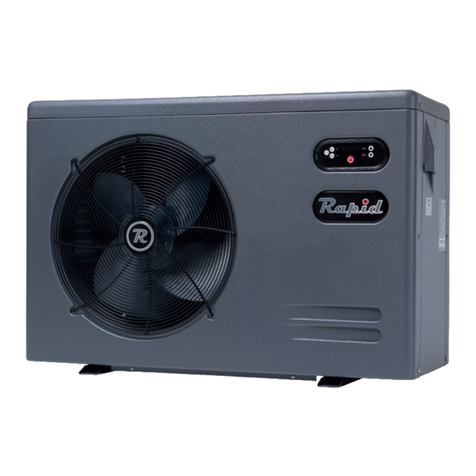
Vagner Pool
Vagner Pool Rapid Series Installation and user manual

AES
AES Remora f6 manual
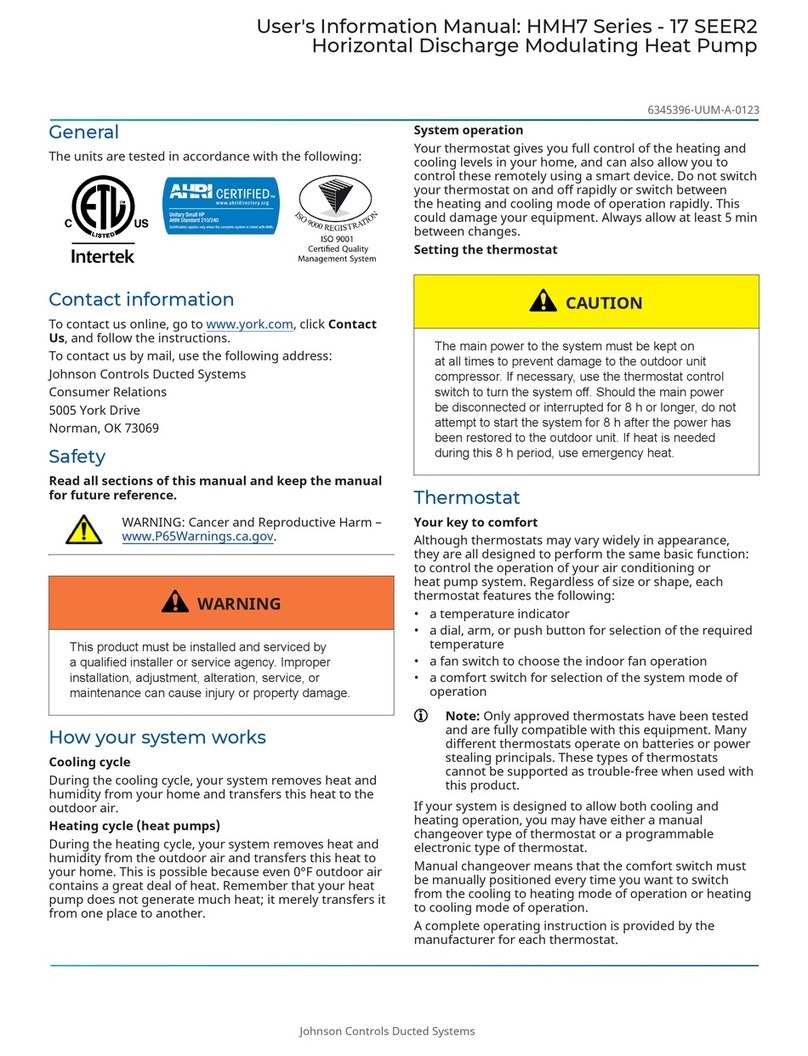
Johnson Controls
Johnson Controls HMH7 Series User's information manual

Bryant
Bryant 548J*D Series installation instructions
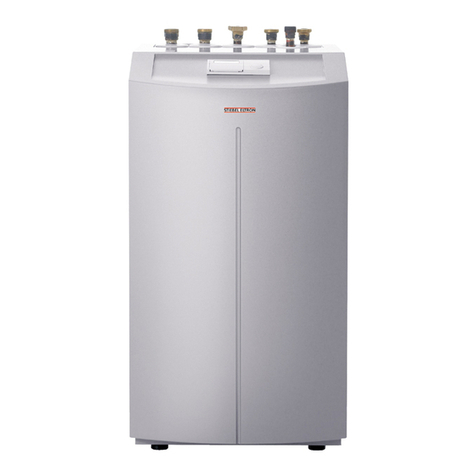
STIEBEL ELTRON
STIEBEL ELTRON WPF 5 Operating and installation instructions

